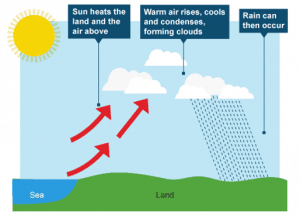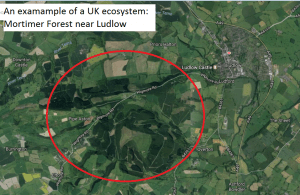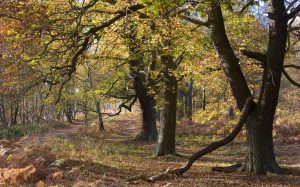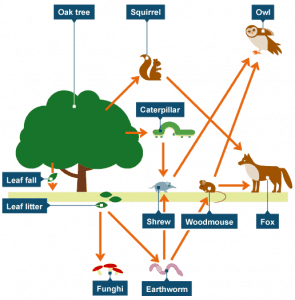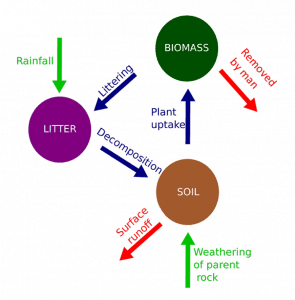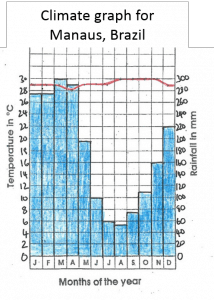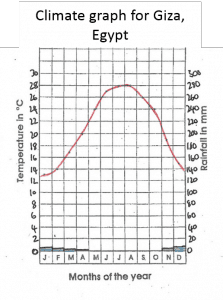Atmospheric Circulation
The equator is hot because the sun’s energy is more concentrated 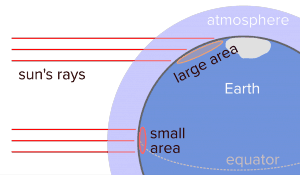 there. At midday the sun is directly overhead. At the poles the solar radiation hits the Earth at an angle so the same energy is spread over a larger area.
there. At midday the sun is directly overhead. At the poles the solar radiation hits the Earth at an angle so the same energy is spread over a larger area.
The hotter temperature at the equator creates lots of convectional rainfall. The sun evaporates water. Warm air and water vapour rises because it is less dense. As it rises it cools and condenses. Water vapour turns back into water droplets. These are clouds. The droplets fall as rain.
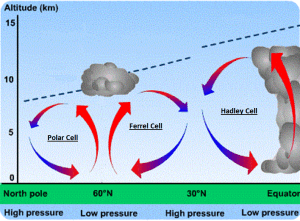 This is part of the atmospheric circulation model. The air rises due to convection on the equator. This creates a belt of low pressure at the equator. The air sinks back to the surface at 30 degrees north and south of the equator, creating high pressure. The Hadley Cell is the main convection current in the atmosphere. A trade wind completes the Hadley Cell, blowing from 30 degrees north back to the equator, before starting the cycle again.
This is part of the atmospheric circulation model. The air rises due to convection on the equator. This creates a belt of low pressure at the equator. The air sinks back to the surface at 30 degrees north and south of the equator, creating high pressure. The Hadley Cell is the main convection current in the atmosphere. A trade wind completes the Hadley Cell, blowing from 30 degrees north back to the equator, before starting the cycle again.
Ecosystem distribution
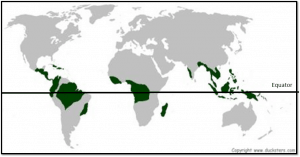 The high temperatures, rising air and convectional rainfall on the equator create tropical rainforests, for example:
The high temperatures, rising air and convectional rainfall on the equator create tropical rainforests, for example:
- The Amazon Rainforest in South America
- The Congo Basin Rainforest in Africa
- The SE Asian Rainforest
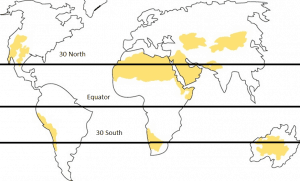 The sinking air at 30 degrees north and south of the equator create deserts, for example:
The sinking air at 30 degrees north and south of the equator create deserts, for example:
- The Sahara Desert in Africa
- The Great Sandy Desert in Australia
- The Mohave Desert in North America
Ecosystems
An ecosystem contains producers, consumers and decomposers
- Producer – a plant that makes its own energy by photosynthesis.
- Primary consumer – an animal that eats plants for its energy.
- Secondary consumer – an animal that eats other animals for its energy.
- Decomposer -an organism that feeds on dead matter and releases the nutrients back to the soil.
These components are linked in a food chain or food web. An ecosystem is a large scale food web.
UK ecosystem example: Mortimer Forest near Ludlow
This is a food web typical of a oak woodland, like the Mortimer Forest. The oak tree is a producer. Primary consumers such as snails, caterpillars and squirrels feed on the leaves and acorns from an oak tree.
Birds and animals, such as owls and foxes, are secondary consumers feeding on other animals.
Plants need nutrients in grow. In an ecosystem nutrients are constantly recycled betwen the soil, biomass (nutrients stored in plant tissues) and litter (dead organic matter on the soil surface). Nutrients can be added or removed from an ecosystem.
Comparing tropical rainforest and desert ecosystems
The nutrient cycle in a rainforest has more rapid recycling of nutrients due to the high temperature and rainfall. Most nutrients in the rainforest are stored in biomass. There is rapid breakdown of litter to release nutrienst back to the soil. In a desert nutrient recycling is slower. Most nutrients are stored in the soil as they cannot be taken up to the arid conditions. The breakdown of litter is slow due to the lack of rainfall and decomposers.
The tropical rainforest has high temperatures all year round (typically 30 degrees C) and a small temperature range. There is over 2000mm of rain a year (convectional rainfall). In the desert there is a greater temperature range but low annual rainfall – officially less than 250mm.
In the rainforest emergent trees have adapted to the conditions by growing tall to reach the light. They need buttress roots to support them and absorb nutrients from the soil surface. Many rainforest plants have large leaves to catch all available light. Epiphytes are plants that grow in the branches of others. They have aerial roots which hang down. Poison dart frogs are brightly coloured to warn off predators. Other animals are camouflaged.
In the desert cactus have no leaves to reduce water loss. They have deep roots to reach water deep underground. They have spikes to stop them being eaten. A kangaroo rat has large ears full of blood vessels to keep cool. They are noctural and only come out at night to avoid the desert heat. They have long back legs to escape from predators.
